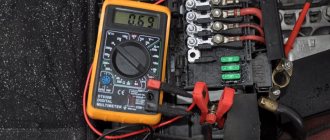Important points
The voltage (U) and capacity of the car battery are the main parameters that need to be paid attention to when choosing and checking a power source.
The main purpose of the battery is to start the engine during the period when the car's generator has not yet been connected to work, and the battery is the only power source.
To eliminate operational problems, the car owner should know the following points:
- What does the battery life depend on?
- What should the voltage be (in normal mode, after starting the engine and under load);
- What causes the decrease in capacity during the cold season and other issues.
Let's consider these questions in detail.
How much should the generator produce to properly charge the battery?
The battery in a car is an important element of the system, which is responsible for providing the car’s on-board network with electricity. The generator is used to charge the battery while it is active. Unstable operation of a device generating electricity causes a voltage drop in the network and failure to restore the capacity of the power source.
Normal generator performance means timely and complete replenishment of the battery charge level, which decreases under load. Checking the battery charge level from the generator is simple and can be done by the car owner himself.
Diagnostics of an automotive energy-generating device includes a visual inspection of the unit, its elements and related parts, as well as voltage and current measurements. At least twice a year, you should check the tension of the drive belt, excessive weakening of which leads to a decrease in the performance of the generator, and sometimes can lead to breakdown of the device.
Diagnostics of indicators such as voltage, current, resistance are also necessary twice a year. To carry it out, you will need special devices - a voltmeter, multimeter or load fork.
What determines the shelf life of a battery?
Each manufacturer, after manufacturing a battery, sets a warranty period for its operation.
In addition to this parameter, there is an actual period that depends on many factors - timeliness of maintenance, compliance with operating rules, condition of electrical wiring and other points.
Due to the fact that battery maintenance conditions differ, the shelf life of the product also differs.
Car owners who use their car only in the warm season have the longest battery life. It's another matter when you need a car all year round, regardless of the outside temperature.
In such a situation, the battery life is reduced. This is also due to the fact that in the second case the driver can cover more kilometers.
The battery life is also affected by:
- Serviceability and correct operation of the generator and voltage regulator.
- Connecting additional equipment with a large rated current to the vehicle's electrical wiring.
- Operating mode. The batteries that last the least are those in taxis that travel a long distance throughout the year. In addition, such cars operate in frequent engine starting mode, which puts a load on the battery and generator. If the vehicle is actively used, the service life of the power source does not exceed 1.5 years.
Under normal operating conditions, when the car owner regularly checks the battery and carries out maintenance, the battery life is 4-5 years with a total mileage of 60-80 thousand kilometers during this period.
To avoid problems, it is advisable to periodically check the voltage of the generator and battery.
But the mentioned service life is not the highest, because with careful maintenance the battery can last up to eight years.
But you should know that sooner or later the battery will need to be replaced, because from the moment you start using it, the working plates gradually wear out. The more charge and discharge cycles a battery goes through, the faster it breaks down.
Practice shows that the key role is played by the generator, its serviceability and current voltage. That is why this aspect needs to be given key attention.
Signs of a generator malfunction
In modern cars, breakdowns of the electrical system are one of the most common. A large number of electronics requires particularly careful monitoring of the operation and condition of the generator and battery, because their failure can immobilize the car. The most common signs of a generator malfunction are:
- battery indicator light on the instrument panel;
- unstable operation of the battery (its boiling over or undercharging);
- different intensity of headlights;
- extraneous sounds from the generator.
If you notice incorrect operation of the car, then perhaps the battery charging current from the generator is insufficient.
All malfunctions of electrical equipment, which includes the vehicle’s energy-generating device, are mechanical (deformation or breakage of fasteners, housing, malfunction of bearings, pressure springs, drive belt, etc.) or electrical (winding breaks, diode bridge malfunctions, burnout or wear of brushes , short circuits between turns, breakdowns, etc.).
Don’t write off a non-working generator: find out if there are repair kits and spare parts. Replace them if possible. If you cannot carry out repair work yourself, then take the generator to a workshop. Many craftsmen will be able to restore the unit at no extra cost and in the shortest possible time.
It will be useful: Test drive Renault Captur 1 6 CVT
However, some breakdowns require the purchase of a new device that generates electricity. For example, a failing bearing that is soldered into the generator housing cannot be restored or replaced in most cases.
Remember that failure of this unit can be caused not only by wear and corrosion, but also by poor quality of elements and components; excessive load; external influence of salts, liquids, temperatures.
What generator voltage is considered normal?
To check the generator voltage, you need to start the engine and turn off the entire load. In this case, the multimeter should show 14.3 -15.5 Volts (see video at the end of the article). A deviation of 0.1 Volt in one direction or the other is allowed.
After this, it is necessary to connect consumers one by one and check the generator voltage.
Ideally, it should “drop” by about 0.2 Volts when you turn on each new load. In this case, the total U should not fall below the level of 12.8 Volts. Otherwise, the battery will be discharged.
Voltage regulator - its main functions
On a VAZ 2110 car, the voltage potential in the generator is formed under the influence of alternating current. This phenomenon becomes possible due to the presence of silicon diodes in the generating device of the vehicle. The generator rotor (the rotating component of the mechanism) operates according to the following diagram:
- first begins to function, which is affected by the current;
- the crankshaft sets the movement of the rotor;
- After this, the generating device itself begins to work.
All stages of the sounded process are monitored by a voltage regulator, which is also often called a relay. It is this that is considered the main control unit of the generator.
Without a regulator, the current-generating mechanism of the VAZ 2110 will not perform its tasks, which are listed below:
- starting the generator;
- control (in offline mode) of current supply;
- “holding” in a certain voltage range.
The described relay cannot be repaired. In the event of a breakdown, the regulator must be replaced, which is done after checking the functionality of this unit.
Minimum battery input voltage parameter
When checking the parameters of the generator, it is worth taking into account the characteristics of the battery itself.
Many car owners are interested in what the voltage at the battery output should be for normal engine starting.
There is no exact answer here, but the average parameter should be 12.6-12.7 V. Depending on operating conditions, this indicator can be adjusted.
Some manufacturers claim that their product has a voltage of 13-13.2 Volts. This parameter is real, but you should not measure the voltage immediately after recharging with a generator or charger.
It is advisable to wait 1-2 hours before carrying out work. In this case, U should drop to a level of 12.7-13 V.
If this parameter begins to “float” or drops below 12 V, this indicates a 50% battery discharge or a generator malfunction.
It is recommended to check the charging circuit or use an external charger.
If you continue to operate the battery in this condition, sulfation of the lead plates occurs, which reduces the performance of the battery and reduces its service life.
In practice, such a decrease in voltage is not critical, because the battery can still be started, and then the generator recharges to the required level.
Rectifier block
This is an assembly of six semiconductors - elements that pass current in only one direction. It is with their help that the voltage of the VAZ 2110 generator is converted from alternating to direct. Consequently, at the output you will receive a stable 12 Volts, which are necessary to charge the battery and power the vehicle’s on-board network. But a stable voltage is possible only if a constant magnetic field is created in the excitation winding.
Only under this condition will there be a stable voltage at the output. Otherwise, it will fluctuate from the minimum value (about 10 V) to the maximum (about 30 V). A block called a relay regulator is responsible for stabilizing the output voltage. If previously exclusively mechanical devices were used, modern cars, including the VAZ 2110, use electronic devices. The VAZ 2110 generator can be installed before the brush assembly with
Generator voltage at idle
To check the functionality of the generator, you need to start the engine and measure the voltage at the battery terminals. Normal U is 13.5-14 V.
If this parameter increases above 14.2 V, we can conclude that the battery charge is decreasing and the generator is switching to an enhanced charging mode.
This situation occurs in rare cases when the battery is discharged due to prolonged standstill in the cold or a connected load.
Situations are possible when the car’s electronics do not allow the generator voltage to increase, based on the ambient temperature.
The increase in U level, which is supplied to the battery from the generator, is not critical. If the electrical equipment of the machine is working properly, after 5-10 minutes the charge voltage will drop to the required level of 13.5-14.0 Volts.
If U does not decrease, it is necessary to begin repairing the power circuit or generator. Otherwise, it will end with boiled-off electrolyte.
If, when the engine is running at XX, the generator produces a voltage of 13.0-13.4 V, this indicates problems with the battery (the latter does not take part of the charge).
In such a situation, it is worth checking the generator when all consumers are turned on - headlights, music, air conditioning and others. We'll talk about this below.
Basic rules when checking a generator
The main rules used when checking the generator voltage are simple, but irrevocable for all car enthusiasts, without exception:
How many volts should a VAZ 2106 generator produce?
- Under no circumstances can the functionality of the generator be inspected for the so-called spark, in other words, using a short circuit;
- It is not allowed to connect the device to the generator terminal “”;
- Welding work cannot be carried out in the body of the car if the wires are connected to the battery and generator.
Generator voltage under load
To ensure the functionality of the power supply, it is recommended to perform a load test.
To begin with, remember that there are three types of voltage:
- Nominal - indicated in the operating instructions. It is 12 Volts. This figure is far from the actual U value.
- Actual . Here we are talking about the voltage parameter after installing, connecting and starting to use the car battery. On average, this parameter is 12.6-13.2 V (this was mentioned above).
- Under load . Here the voltage parameter supplied by the generator can change.
The presence of a load allows you to verify the health of the battery and generator.
A seemingly serviceable battery with an output of 12 V can drop significantly after switching on the consumers. During the testing process, an additional device is used - a load fork, which allows for an increased load on the battery.
If your battery capacity is 60 mAh, the load value should be 120 A. The connection duration is 3-5 seconds.
We can say that the power supply is working properly if the voltage does not drop below 9 Volts. If the parameter drops to 5-6 V, this indicates a complete discharge of the battery. After testing under load, the voltage should return to 12.2-12.4 V.
If a strong drawdown is detected, it is necessary to check the battery, and then repeat the experiment with the plug again. If there is no drawdown, we can talk about the health of the battery.
To check the generator, you can do the following: start the car, turn on as many consumers as possible, and then take a measurement. The voltage should be 13.5-14 V.
If it is lower, this indicates a failure of the generator. The lower critical limit is 13.0 V.
If the voltage of the car's generator is very low, do not rush to draw conclusions - make sure that the contacts on the battery are not oxidized. If so, rub them with sandpaper.
Charging voltage of a car battery from a generator
A properly charged battery is an indispensable condition for a comfortable ride. In the cold season, it is especially important that the battery ensures reliable starting of the car engine. Modern cars, especially executive cars, have a battery charging control unit that monitors the main parameters of the process. There are no such devices in budget category vehicles. Experienced drivers perform this task independently. Let's look at how to have the most complete control over the battery charging process.
Causes of battery charging failure
The main parameter in the battery charging process is the charge current. Many parameters depend on its value.
Capacity replenishment speed
There is an opinion that for normal battery charging, the charge current should be 10% of its capacity, i.e. with a battery capacity of 50 Amp*hours, the charging current will be 5 Amps. Under such conditions, a completely discharged battery will gain its capacity up to its nominal value of 10 hours. Imagine, you were started from the wires of another car in the winter, and in order to fully charge the car battery, you need to drive the car for 10 hours in a row, that is, drive kilometers five hundred. It is believed that to replenish the battery charge to the nominal value, it is enough to drive 30 kilometers in a normal cycle, and in city traffic jams half that. That is, if your work is located more than 10 kilometers from home, this is enough not to worry about recharging the battery outside the car.
The case is different when work is close to home. You spent the capacity when starting the car, quickly drove to work, and then also home. After a week or two, your battery runs out. And not at all because there is something wrong with the car, it’s just the rhythm of the drive.
In this case, you should think about warming up the engine even in the warm season just to ensure that the battery is always in a charged state. Let's return to the charge current. If it is enough to drive a car 30 kilometers to fully charge the battery, and not 500, as in the example, therefore, the charging current of the car generator is not 5 Amperes, but much higher.
Battery life
The normal battery life is more than five years. Used cars imported from abroad have fully working seven- to nine-year-old batteries on board. There, however, the storage conditions for cars are different, and the temperature in winter is higher. There are three reasons for the low durability of the battery: violation of the battery charging regime, the quality of the battery, the human factor, in other words, laziness. Let's start with the first. If the battery is not charged to full capacity all the time, the plates undergo a sulfation process. Sulfation, or the formation of lead sulfate on the plates, can be compared to a stomach ulcer in humans, only in humans it can be treated, but a battery ulcer is practically untreatable.
There are various methods of complete discharge-charge, charging with pulsed currents. Maybe there is some percentage recovery, but if the battery is completely dead, then alas...
The quality of the battery depends on the manufacturer. Modern technologies only affect the increase in battery capacity while reducing the size and weight, respectively, the amount of lead. How to choose the best quality battery? If there are two different copies with the same capacity, starting current, cost, it is better to buy the one that is heavier, it has more lead, it will last longer. About the human factor. The biggest mistake car owners make is parking the car in the fall with the battery until spring.
If the battery spends several months in a discharged, not even fully charged state, and even in the cold with a reduced electrolyte density, it is unlikely to survive until spring.
If you periodically use the car in winter, then regularly (a couple of times a week) you need to start the car and warm it up for at least fifteen minutes, checking the charging voltage. If the car is not used in winter, it is better to remove the battery from the car, fully charge it and store it in a warm room , recharging once a month. During everyday use of the vehicle, it is necessary to regularly check the charging of the battery from the generator.
How to check battery charging from a generator
Checking the battery charging process is possible using the following methods:
- visual diagnostics;
- computer diagnostics;
- diagnostics using physical measuring instruments.
Visual control
Visual diagnostics can and should be done at least once a week. In the summer, it is imperative to monitor the electrolyte level either through the light or through the electrolyte topping holes. If the battery is maintenance-free, monitor the indicator window. When the recharging process is in progress (the charging current is too high, it is possible if the generator is faulty), the electrolyte boils away. This leads to an increase in acid concentration, corrosion of the plates, and an even greater increase in current and temperature. Video - charging voltage of a car battery from a generator, leakage currents and other checks: Such an avalanche-like process can destroy the battery in a couple of hours. Therefore, if you see any changes in the paint, foreign deposits, or a change in the shade of the battery case near one of the cans or electrolyte refill caps above the battery installation site, immediately determine the cause. If the control window of the battery during constant operation is not in the green zone, This means that the charging process is disrupted.
The visual method also includes monitoring the “battery” light on the dashboard. If it does not light up when the ignition is turned on, or does not go out after starting the engine, or flickers depending on the engine speed, then the battery charging process is disrupted.
Another tip for visually checking the charging process. In the dark, pay attention to the brightness level of the low and high beams when changing engine speed. This is best done by lighting a white wall. If the brightness increases with increasing engine speed, it means that the voltage-current regulator in the generator is not working properly, you need to check the generator.
Computer diagnostics
Computer diagnostics of cars equipped with a battery charge controller will give a complete picture of the operation of the generator, charge control unit, and battery performance level. But there are few such cars. Conventional computer diagnostics will provide information about the voltage of the on-board network. But it can also be obtained using a regular multimeter.
Diagnostics using devices
Experienced drivers remember that a garage tool always included a hydrometer and a load fork. A battery hydrometer is used to measure the density of the electrolyte. Normal density is from 1.23 to 1.28 g/cm3. The lower the temperature, the higher the density must be, otherwise the battery will freeze and fail. Using a load fork, you can identify a “rotten” can and repair it.
The most universal device for monitoring battery charging is a multimeter. How can I use it to check the battery charge?
First, before driving with a cold engine, measure the voltage at the battery. It must be at least 12.5 Volts. Turn on the ignition. In a normal case, the voltage will drop by 0.1 - 0.3 Volts, but it must still be at least 12.4 Volts to start the engine. Next, we start the engine. Check the voltage on the battery. In the case of a normal battery charging process, the voltage should be in the range from 13.5 to 14.5 Volts. If the voltage is higher, the battery is being recharged. This is possible in the following cases:
- the generator is faulty (voltage regulator, diode bridge, short circuit of the excitation winding);
- Lost battery capacity (aging, boiling, destruction of plates);
- violation in the battery charging control unit (if equipped).
If the voltage is less than 13.5 Volts, this indicates that the charge is weak, the generator voltage regulator is not working properly, and there may be problems with the wiring. If the voltage has not changed at all, on the contrary, it has decreased, it is necessary to check the generator or electrical wiring. Using a multimeter, you can charge current measurement. To do this, you need to disconnect the thick wire from the generator. Carefully insulate it (there are + batteries on it). Next, connect one multimeter probe to the free contact of the generator, the other to the positive of the battery.
Switch the multimeter to the “current measurement” mode to the 10 Ampere limit. Start the engine. The charging current will initially be large (more than 5 Amperes), then as the battery charges, it will decrease.
Checking the battery charge must be done at least once a month, and more often in winter. After all, at this time of year, the safety of the driver and passengers depends on the proper operation of the battery. Video - how to check battery charging from a generator: May be of interest:
Voltage on the generator for charging the battery
It is no secret that when charging a battery using a stationary charger, the input voltage should be about 18 V.
At the same time, it is necessary to monitor the voltage level at the battery terminals. As soon as U stops growing, we can talk about a full charge. If you continue the process, the electrolyte may “boil”.
After starting the engine, the charging current is at the level of 5-10 Amperes (sometimes more), but after a few minutes it drops to 1-3 A, which is considered the optimal parameter for the battery.
An indirect indicator of the normal operation of the generator is the voltage at the terminals a few minutes after starting the engine. This indicator should be at the level of 13.9-14.2 V.
Reasons for low charge output
There are two reasons why the VAZ-2110 generator produces a low charge:
- Mismatch between the battery and the car's generator.
- Overload.
For the first reason, the generator may produce little charge due to the fact that owners of VAZ-2110 cars install additional electrical equipment. To do this, they also purchase and install a much more powerful battery. In this case, the generator does not have enough resource.
The second reason suggests that motorists overload the VAZ-2110 generator with various video devices, various speakers, electric pumps, etc. Additional devices greatly reduce the charge.
It is worth paying attention to how much it is necessary to supply to the VAZ generator for normal operation of the entire mechanism. This norm always depends on the technical condition of the car itself as a whole:
- if the car has driven a long enough distance, the generator can produce a voltage of 14.0-14.2 V;
- if the car is parked and has a cold engine, the charge will be 14.2-14.4 V.
Also, a lot of reasons can be attributed to the low charge of the VAZ-2110 generator. These can include such as wire breaks in the winding, weak contacts, and stator short circuit. The closure of the rotor housing and the interturns also affect the small charge. Mechanical problems with the generator affect the decline in performance.
In order to finally make sure that the VAZ-2110 generator cannot produce the required charge, it is necessary to find the final reason. First of all, you must disable all installed additional equipment that is not included in the complete vehicle package. This includes a navigator, audio speakers, video recorder, etc. Next, it is important to measure the return current output when the engine is cold, remembering to turn off the entire life support system of the car. It's good if there is no return. If this occurs, the battery will discharge very quickly. After performing a repeated drive, you will finally be convinced that there are no problems in the battery, and it is not the reason for the VAZ-2110 generator to issue a low charge. All removed devices can be reinstalled.
The next step in checking that the generator is not capable of delivering a charge is to check the power delivery mechanism itself. The reason may be quite serious. This is both insufficient contact of the brushes with the rings and a break in the wires in the winding. The generator can heat up and hum due to the short circuit of the excitation coil, or a phase failure of the stator winding. It is also capable of delivering a bad charge (small) due to mechanical deviations.
A few words about electrolyte
One of the main indicators by which you can judge the health of a battery is the electrolyte level. The voltage of the power supply depends on it under different operating modes.
In the process of discharging the battery, acid is consumed, the share of which in the total volume of liquid is a third (35-36%).
The result is a decrease in the density of the liquid. When the battery is charged, the reverse process occurs.
In such a situation, water is consumed, and acid, on the contrary, is formed. As a result, the density of the electrolyte increases.
In the normal state, when the battery voltage is 12.7 V, the density is 1.27 g/cc. Moreover, all parameters directly depend on each other.
How many amperes does a car alternator produce per battery?
The current strength required by the electrical system of each car is individual and depends on the number of electricity consumers and their values. And also the charge current must be sufficient to charge the power source.
It is worth noting that ampere readings appear only when there is a load in the vehicle’s electrical system and, accordingly, the battery is discharged. After starting the car engine, the charging current is about 6-10 amperes and drops over time, because the battery is charging, taking on the main energy consumption. If you turn on additional equipment - headlights, radio or heated mirrors, you can see an increase in the charging current values.
When purchasing a generator, pay attention to its technical characteristics, which the manufacturer indicates on the case - that’s where you will find information about the maximum current that will flow to the battery.
In the table below you can see the approximate current values that the generator shows at different loads.
Reduced tension in winter: what causes it?
Sometimes car owners are faced with a situation where, during the cold season, the battery parameters deteriorate and the car cannot be started.
To avoid problems, prudent drivers remove the power source and take it to a warm place.
In fact, the essence of the problems is as follows. When the temperature drops below “zero”, the density of the electrolyte also changes. Consequently, the voltage level is also adjusted (as noted above).
Even with normal charging of the battery, the density of the electrolyte increases, which is why U also increases. Therefore, if the battery is normally charged, it has nothing to fear.
The situation is worse if you leave a discharged battery in the cold. In this case, the density will drop and problems with starting the motor will appear. In some cases, the liquid may freeze.
As for the problems associated with starting a battery in the cold season, they arise due to the inhibition of chemical processes inside the device when the temperature drops below zero.
This means that with a normal charge, the density and voltage of the battery will be sufficient to start the engine even in winter.
Knowing what voltage should be on the car's generator, you can avoid premature failure or battery discharge, as well as timely diagnose a malfunction of the generator itself.
Basic malfunctions and search for their causes
As already mentioned, during normal operation of the electric generator, the light on the dashboard will light up at the moment of ignition, and after starting the engine (and, as a result, the generator), it will immediately go out.
Guided by the “behavior” of this light bulb, you can try to determine the cause of the malfunction in the on-board network:
- when the ignition is turned on, the light does not light up, there is no illumination of instruments and other light bulbs - there is a break in the network;
- at the moment of ignition, the light does not light up or lights up dimly - the battery is discharged;
- The light comes on very brightly and continues to glow when the engine is running - the battery is overcharged, there are problems with the voltage regulator.
In order to perform a full check of the generator, you need to:
- Turn the ignition key and make sure that all warning lights come on.
- Start the engine and see if the warning light goes out.
- After warming up the engine, turn on all electrical consumer devices to create the maximum load in the network.
- Set engine speed to 3,500 rpm.
- Connect the multimeter in DC voltage measurement mode to the battery and take a measurement (you can find out exactly how much the VAZ 2114 generator produces in the instructions supplied with the car. Nominally, the operating voltage on the battery when consumers are turned on should be about 13 volts).
- If the voltage of the VAZ 2114 generator is below 13 volts, then there are problems with current generation, and if, with consumers completely turned off, the voltage does not rise above 14.7 volts, then the voltage regulator has failed.
One good way to check the health of the generator is to listen to it. To do this, you should start the engine and listen carefully to the operation of the device - if a running generator makes loud sounds, then most likely its bearings have collapsed and will have to be replaced.
By the way, one of the reasons for the rapid wear of generator bearings is an over-tight drive belt - if the tension is correct, its lateral deflection when pressed with fingers should not exceed 1.5 cm.
For a deeper check of individual components of the generator, you will have to use a probe - a 12-volt light bulb with a power of 3 W.
The check is performed as follows:
- alternately connect the light bulb on both sides to each of the diodes in the presence of current from the generator. Since diodes are transparent only in one direction, the light bulb should not light up (if it lights up, then the diode is faulty);
- connect the probe to the generator brushes. When the voltage reaches 16 volts, the light should go out. If this does not happen or, conversely, the light does not even light up, then the voltage regulator has failed;
- perform a “continuity test” of the state of the stator windings (for this purpose it will be more convenient to use a tester). If it turns out that there is a short circuit, the stator will have to be replaced.
Thus, checking the functionality of the generator is a fairly simple task. The most important thing is to do it periodically to find faults as soon as they appear. This will help avoid more serious problems and malfunctions in the on-board network.
Troubleshooting
A lot depends on the operation of the VAZ 2110 generator. If it malfunctions, what can start the battery? And when it stops providing the required voltage, you have to urgently figure out what the reason is. But just by external signs you can determine that the generator is creating problems:
- The charging light starts flashing at low speeds;
- there may be a burning smell in the cabin;
- there are mechanical damages.
If a visual inspection does not bring results, you must:
- remove the plastic cover from the generator;
- check all electrical connections;
- Unscrew the diode bridge, as well as the voltage regulator relay with brushes.
Diodes are checked with a special tester. When they operate normally, the current will only flow in one direction. If the current flows in two directions or the diodes do not pass it at all, then the reason has been found.
The cause of poor performance may be the belt. If it is worn out, it can be seen immediately. If the generator winding “flies”, it is better to entrust the solution to this problem to a specialist.
Search
Normal voltage indicator in the VAZ-2110 generator
In order for the car to work normally and not break down on the road, the motorist must constantly monitor the technical health of his “four-wheeled friend,” paying the same attention to the generator. If the device fails, the battery will not be able to receive electronic recharging, after all, the machine will only run on the rechargeable battery's recharge for a short period of time.
When the battery runs out, the engine will stop and the car will stop anywhere. In this case, the motorist will have to find a lot of money to buy a new generator, test and install it. And here is the process of technical health monitoring, where the most important thing is to track what specific stress should be released while driving a VAZ-2110 generator , help save money and know that the car will in no way let the owner down. If you notice that the generator is running intermittently, it is necessary to check the functionality of the device, especially because without the help of other people, it is quite easy to carry out this process, taking into account the advice and recommendations of experts in your own business. However, before starting work, the motorist must familiarize himself with certain rules that will help check the operation of the device without damage.
Basic rules when checking a generator
You may also like
The basic rules used to check the generator voltage are simple, but irreplaceable for all motorists without exception:
- in no case can you check the functionality of the generator for the so-called spark, in other words, through a short circuit;
- It is prohibited to connect the device to the generator terminal “”;
- Welding should not be done behind the machine if the wires are connected to the battery and generator.
VAZ Generator. increase the voltage in the on-board network.
By measuring the voltage, he concluded that my battery was charged. Here's how I solved the problem.
Check the battery charge from the generator.
After replacing the brushes. Check the battery charge.
When checking voltage, it is important to consider the following points:
- measurements are made using special instruments called voltmeters and ammeters;
- check the device valves in this case if the voltage does not exceed 12 V;
- If you need to replace voltage test wiring, you must select similar wires in both cross-section and length.
Before checking, you need to make sure that all connections are working correctly and the device belt is properly tensioned.
You may also like
To make sure that the belt is tensioned properly, you need to press on its middle, using all this force of 10-12 kgf. When properly tensioned, the belt should flex 12-15mm or less.
Step-by-step check of the car generator regulator
Check the voltage the car VAZ-2110 generator release . This is not difficult if the tests are carried out in stages, and the motorist takes into account the advice of professionals:
- First you need to start the car engine by selecting medium speed and turning on the lights. The machine should operate in this mode for about 20 minutes. The indicator, as mentioned earlier, is measured by a voltmeter, the measuring scale of which is from 0 to 15 V, or an ammeter.
- Defines the voltage between the generator input "" and the weight of the block. If the generator is running, the device's correct scale rating should not exceed 14.5 V. If these devices are above or below standard, then most likely you will have to replace the faulty controller.
- You can measure voltage in another way, in which a voltmeter is connected directly to the battery. However, the resulting figure will only be accurate if the wiring of the vehicle is completed.
- You can check the voltage using a special lamp located on the dashboard, it is called a “control device”. In the interval between turning on the ignition and starting the engine, the control indicator should be on to monitor the generator voltage. If the lamp goes out when starting the engine and does not come on again, this will mean the generator is working normally, without interruption.
In other cases, for example, if the check light is bright while the engine is running, check the voltage of the alternator belt or the serviceability of the entire charging circuit. In some cases, the flashlight indicates that the entire device is faulty, in which case it will have to be replaced.
What malfunctions can occur in the generator?
What could be the problem with the generator when, when you turn on the ignition, the light flashes or does not turn on at all and the control devices do not function? You should check to see if the fuse located in the mounting block is ok. If there is a break in the power supply, the following may occur:
- the “O” wire with the wires from the mounting block to the devices is broken;
- there was a breakdown of the “GP” wire with the wires from the ignition switch to this unit.
When the switch does not work due to breakdowns, it is enough to replace only the contact part that has become unusable.
If the battery is discharged, the generator voltage will not give the desired figure.
And the reason may lie in the fact that the control lamp has burned out, or perhaps the socket contacts are not pressed sufficiently against the printed circuit board. In this case, the lamp or faulty contacts are replaced.
You should look to see if there is an open circuit in the circuit connecting plug “D” of the generator and the devices. If this is exactly the case, then you need to look at the “KB” connections.
A lot also depends on the brushes if the VAZ 2110 generator does not produce the required power. They can wear out, freeze, the contact rings can oxidize, then you need to replace the entire brush holder along with the brushes. Oxidized parts are wiped with gasoline.
Why does the VAZ 2110 generator not charge and how to fix it?
If you discover that the generator on your VAZ 2110 does not charge, you should immediately look for the cause of the malfunction, because the supply of current to all electrical equipment, as well as charging the battery, is at risk. Alternator As you know, with a working generator, the battery does not require charging for many months and years , while maintaining at least 60% charge. That is, a battery with a capacity of 55 Ah, which is usually equipped with dozens, is replenished with current due to the operation of a working generator.
Generator types
Most often, the VAZ 2110 (with a carburetor engine) is equipped with a generator 9402.3701. On VAZ the injector is 3202.3771 (with a poly-V belt). But in any case, the problems are the same, we will consider them. Generator 3202.3771
Basic problems
If the generator begins to act up, then the main causes of the malfunction should be sought either in the on-board network, or these are problems with the generator itself. If the generator gives a charge, but not enough, then perhaps it has been “loaded” too much by installing many other gadgets in addition to the standard electrical equipment, and it is already working at the limit of its capabilities. Our motorists really love tuning the VAZ 2110, adding, for example, speaker power, amplifying light, etc. In such cases, some people change the battery, for example, put it with a capacity of 70 Ah, instead of the usual VAZ one with 55 Ah. But although this may help at first, over time such a battery will run out even faster, since the standard generator will not be able to fully charge it , he doesn’t have enough power for this.
troubleshooting
To accurately determine the source of the problem with the generator, you need to perform a basic check. If you do not have “additional” energy consumers, you can immediately look for generator faults; if there are any, turn them all off for a while. Moreover, do not turn it off, but rather disconnect it from the car. Test plan:
Now let's look at all of the above generator malfunctions in more detail.
Weak contact
The contact may become weak if the brushes and rotor slip rings are dirty or oily. Another culprit is shrinkage of the springs pressing on the brushes, as well as freezing of the brushes themselves. These deficiencies can increase the excitation resistance and even interrupt the circuit. Wiping with a rag soaked in gasoline usually helps. Severely worn brushes must be replaced with new ones, and the springs must be checked at the same time. If the rings have oxidized, cleaning them with glass sandpaper will help.
Winding break
If the excitation winding is broken, then there is no charging of the battery. To determine this, it is often enough to place your hand on the generator. When it breaks, it heats up. For an accurate check, you need to disconnect the end of the excitation winding from the brush, connect the battery wires (via a voltmeter or a light bulb) to the terminal Ш of the generator. If there is a break, the voltmeter needle will not deviate and the light bulb will not light up. To find which of the coils prevents the generator from working, connect the wires from the battery to each individually. Finally, check the soldering and coil terminals. If the break is internal, the coil needs to be replaced; for external ones, soldering helps.
Interturn closure
An interturn short circuit may occur in any of the field winding coils. In this case, the winding heats up and the excitation current increases. To determine the short circuit, it is not enough to note which one is heating up; you need to measure the resistance of each coil with an ohmmeter.
Short circuit to the rotor housing
With this malfunction, the entire field winding is closed, and the generator simply does not work. Most often it shorts to the housing in the places where the winding ends lead to the rotor slip rings. They check this with a light bulb with a voltage of 220 V. One wire is connected to any slip ring, the other to the rotor core or its shaft. If there is a short circuit, the light will light up. You can’t go anywhere with such a generator, so you need to either insulate it or replace the winding.
Short circuit in the stator phase winding
Most often, a short circuit occurs when the insulation between the turns in the stator coils is destroyed. At the same time, the generator gets very hot, it does not charge the battery enough, since this only happens at very high crankshaft speeds.
The stator shorts to the housing
As with other short circuits, there is something wrong with the generator: it gets very hot, hums, and its power decreases. The test is carried out using a 220 V lamp. One terminal is placed on the core, the other on one of the winding terminals. If there is a short circuit, the lamp lights up. Repair consists of replacing defective coils.
The plus clamp closes to the body
This malfunction not only leads to severe overheating of the generator, but also to breakdown of the diodes in the rectifier unit. Which, in turn, causes the battery to short out. It can not only be severely discharged, but also fail.
What voltage should the generator produce on a VAZ 2110?
If the generator produces 12 volts, what should I do?
Low voltage at the generator output is dangerous because it does not provide a full charge to the battery, as a result of which the battery can quickly discharge.
There may be several reasons; for accurate diagnosis and repair, it is advisable to contact a service center.
Among the main reasons are a malfunction of the charging relay, a break in the winding excitation circuit, or a malfunction of the diode bridge.
What voltage should be on the battery when the VAZ engine is running?
When the engine is running, the voltage readings are slightly higher than when measured directly from the battery when the car is at rest. When the engine is running, the battery voltage fluctuates between 13.5 - 14.0 volts.
Will a generator from a Muscovite fit a VAZ 2112?
In terms of voltage and wires, a generator from a Moskvich can be installed on a 2112. The only problem will be in the mounting, since they are different and you will have to do a little work to install the generator from Moskvich. And by the way, the battery charging lamp may not light up, or vice versa, it may light up and not go out, but this is a problem in the very structure of Moskvich batteries and it does not affect its performance.
How to increase the voltage of the on-board network in the VAZ-2107 generator?
One of the actively discussed methods is the following: almost any 10A silicon diode is soldered into the generator circuit. You can see how this is done, for example, here: https://www.youtube.com/watch?v=ZQVWDITkiG4
Many experienced drivers speak of this method as an effective means. Measurements of the voltage taken from the battery after installing such a diode show an increase to nominal values. The promotion of this method was facilitated by a positive assessment in the magazine “Behind the Wheel”.
However, this method has many critics. Some consider a slightly reduced voltage from the battery to be quite workable, another part predicts a quick failure of the battery, others call this method “collective farm tuning” and suggest buying a good imported battery to solve the problem.
How many volts should a VAZ 2115 generator produce?
How to check the generator on a VAZ 2114 car The VAZ 2114 is equipped with an electric generator 94.3701, which is installed on injection power units for modern cars of the Samara and Samara 2 series. This is a unit with alternating current, three phases, right rotation (projection from the drive), it has a built-in rectifier unit and a voltage regulator.
Design and features of using the VAZ 2114 generator
An automobile electric generator is a synchronous, three-phase alternating current electrical machine with electromagnetic excitation. It converts the mechanical energy of a running auto power plant into electronic energy, necessary for the operation of electrical systems and other devices and equipment that consume electricity when the engine is running. For this purpose, a rotating magnetic field is used for transformation. The main working parts of the auto generator are:
- rotor - the moving part of the device
- stator - the stationary part of an electronic machine
The stator is assembled from pieces of sheet iron that are insulated with each other. Inside the stator, the generator's armature winding is laid in grooves. The rotor core is machined from a solid piece of electromechanical steel. Pole pieces are assembled from sheet steel. Excitation coils are placed on the poles, which are powered from an external source of constant current.
How many volts should a VAZ 2114 generator produce?
There is a housing for protection from external influences. The main working parts of the auto electrical unit are contained there. Available:
- bearings - for them the rotor rotates;
- impeller;
- diode bridge;
- relay regulator;
- The pulley is the drive; the belt goes there.
The front and rear covers of the generator, which make up its body, are firmly bolted to the starter, ensuring its immobility. The rear bearing is firmly mounted on the rotor shaft and covered with a bushing. The front bearing is pressed into the front cover of the electrical unit and can only be replaced together with it. The shaft itself rotates on bearings; their lubricant, filled at the factory, does not change. The winding in the stator grooves is assembled in a “star” configuration. In this case, the wires are brought out to a common point.
At the same time, the phase wires are connected to the diode bridge. There are 6 pieces of diodes made of silicon, also called “valves”. There are three positive and three negative.
They belong to the poles and are pressed into duralumin plates shaped like a horseshoe. There are also three more diodes on the plate. When starting the power plant, the field winding is powered through them. The diode bridge is fixed on the back cover. There is also a capacitor that protects against large surges. There is a control light on the dashboard that lights up when the ignition is turned on. Under such circumstances, voltage is supplied through the light bulb from the battery to the field winding.
After turning on the power plant, the winding is powered by additional diodes and the light should go out.
If after starting this does not happen and the light continues to shine, this means the VAZ 2114 generator is not working.
How many volts should a VAZ 2106 generator produce?
Battery icon on dashboard
Features of using the unit 94.3701 on the VAZ 2114
- The electric unit must not be allowed to operate with the battery disconnected. This causes voltage surges with possible damage to generator components and vehicle systems.
- Make sure that the plus of the battery is always connected to the terminal of the electrical unit, and the minus to ground. If you mix up the contacts, a stronger current will flow through the diodes and they will suffer a breakdown.
- Under no circumstances should you test a car electrical unit for a “spark”; the diodes will instantly break due to a surge in electricity. It is necessary to check only with the help of special meters or on a stand.
- The valves cannot be controlled with a voltage greater than 12 V or with a megger, this may lead to a short circuit.
- The car's electrical wiring should only be checked with a megger or voltage greater than 12 V with the electrical unit turned off.
- If it is necessary to electrically weld components or body parts, it is imperative to disconnect the wires from all terminals and connection points of the electric generator and battery.
- When the ignition is turned on, the light on the dashboard does not light up and the main instruments do not work.
- The control lamp did not light up after turning the ignition key and does not light up after starting. The battery is low.
- When the machine is running, the light glows brightly or dimly. The battery is low.
- The light glows brightly when the car is running. The battery is overcharged.
- Increased noise level during operation of the electric generator.
- insert the ignition key, turn it and check that all warning lights are on at full strength;
- start the engine - the warning lamp should go out, if it glows brightly or not at full strength, therefore there is a problem in the generator circuit;
- when the engine warms up to operating temperature, turn on all electrical appliances to create maximum load;
- to connect the meter in voltmeter mode, read in the operating manual what voltage
the VAZ 2114 generator should produce - set 3500 rpm;
- connect the meter to the battery and check the voltage; if the device shows less than 13 volts, then the battery is discharged and you need to look for a breakdown. This may be a poorly tensioned belt, a failure in the regulator, worn out brushes and oxidized contacts;
- turn off all devices as much as possible and find out how many volts
the VAZ 2114 generator
should
produce With consumers turned off, when measuring with a battery probe, the reading should be at least 14.7 volts ; if it is much more, then the regulator on the unit must be changed; - without turning off the car, listen to how noisy
the VAZ 2114 generator One of the reasons is an overtightened drive belt; - turn off the car, let it cool and check how the belt is tensioned by pressing on it with your finger, the deflection is one, maximum one and a half centimeters.
Well, that's another matter))
How many volts should a VAZ generator produce?
TRN 67.3702-02 this model fits my generator
3202.3771, installed without problems, the voltage is noticeable.
Checking the VAZ 2114 generator and typical malfunctions
Before you check the generator for the VAZ 2114, you need to find out what faults can be detected during testing and how these faults manifest themselves.
Failures that occur during operation
Checking the VAZ 2114 generator with the car engine running
In preparation for checking the unit, you need to buy a special measuring device for monitoring the automotive electrical network. The control procedure is as follows:
How many volts should a VAZ 2112 generator produce?
Checking the elements of the unit and its maintenance
Deep instrumental monitoring of the VAZ 2114 generator includes diagnostics of the diode bridge, regulator, stator and rotor windings using a probe (this is a 12 V light bulb with a power of 3 W):
- the diodes used are one-way, the lamp should not light up, if it lights up, then the diode is broken;
- when the regulator is checked, the probe connected to the brushes should
go out if it increases to 16 volts; if it continues to light or, conversely, does not light at any voltage, then this indicates a malfunction of the regulator; - By monitoring the windings, they look for a short circuit or its absence. If a short circuit is detected, the stator must be replaced.
In order to be confident in the performance of your generator, you need to check it every 10 thousand kilometers, and regularly service it between checks, that is:
- keep surfaces clean;
- check the mounting of the generator to the engine and the reliability of all terminal connections with wires;
- check the tension and condition of the belt;
- check the condition of the bearings by ear and when rotating the pulley with the belt removed.
As a recommendation, experienced drivers advise those who constantly drive long distances to have an alternator drive belt in the trunk as an emergency supply. And the driver himself can take a master class on how to replace it. A belt break is a common malfunction and it happens according to the law of the road in a deserted area. Unfortunately, the car cannot move without a belt. So the reserve will be useful.
How many volts should a VAZ 2110 generator produce?
Rectifier module
The rectifier module is designed to convert alternating current into direct current. It is based on six silicon diodes (gates): three positive and three negative. They are located on two horseshoe-shaped plates. To smooth out voltage surges, the terminals of the positive and negative diodes are connected through a 2.2 μF capacitor.
How to check the generator on a VAZ-2110 for the functionality of the rectifier unit with your own hands? To do this, you will need a regular car tester or test lamp. The essence of the test is based on the ability of diodes to pass current in only one direction. A faulty valve either does not pass current at all, or passes in both directions.
So, first you need to remove the casing of the rectifier unit. Next, connect the first wire of the test lamp to terminal “B” of the generator, and the second to the ground of the device. If the unit is working properly, the lamp should not light up. If it lights up, there is a short circuit in the rectifier and it needs to be replaced.
Don't be lazy to check the capacitor as well. Turn the tester into ohmmeter mode (1-10 MOhm) and measure its resistance. For a working capacitor, it should first take a minimum value and then gradually increase. If this does not happen, replace the capacitor.
What kind of charging should go to the battery from the generator?
It is traditionally believed that 13.5-14.5V should be supplied by the generator to the battery and this is absolutely enough to replenish the battery costs.
It is worth considering that using a battery with a higher power in a car than the manufacturer recommends also requires the installation of a more productive generating device.
It is necessary to take into account the load that the generator must withstand - it is calculated based on the maximum indicators of all electrical appliances and car systems.
Do not forget that the charging current from the energy-generating device will allow you to start the car in the cold season. In order to avoid problems with starting the car, we recommend purchasing generating equipment, the charge current of which will be approximately 10% of the capacity of the power source. That is, a battery of 100 A/h requires a generator that can produce 10A. Please note that for many cars, 100 amp equipment will operate at its maximum capacity, because the power consumption of the automotive system is in the region of 80 amps. Therefore, the choice of a source generating energy must take into account both the battery capacity and network consumption.
It will be useful: Where is the dipstick on the Peugeot 307 automatic transmission
Step-by-step check of the car generator regulator
It is not difficult to check what voltage a VAZ-2110 car generator should produce if the test is carried out in stages, and the car owner takes into account the advice of experts:
- Initially, you need to start the car engine, selecting medium speed and turn on the headlights. The car should remain in this mode for about 20 minutes. The indicator, as mentioned earlier, is measured with a voltmeter, the measuring scale of which is from 0 to 15 V, or with an ammeter.
- The voltage between the generator input “+” and the mass of the unit is determined. If the generator is working properly, the indicator on the device scale should not exceed 14.5 V. If the device data is higher or lower than the established norm, then most likely you will have to replace the failed regulator.
- You can measure the voltage in another way, in which a voltmeter is connected directly to the battery. However, the resulting indicator will be accurate only if the car wiring is completely intact.
- You can also check the voltage using a special lamp, which is located on the dashboard; it is called a “control device”. In the time interval between turning on the ignition and starting the engine, the control light should be on, which allows you to control the voltage of the generator. If, when starting the engine, the lamp goes out and does not light up again, this will indicate that the generator is operating normally, without interruptions.











